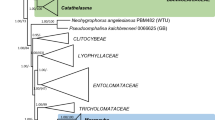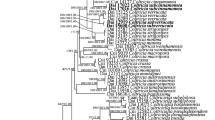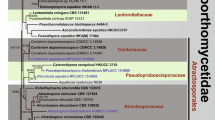Abstract
A new classification of several clitocyboid taxa is here proposed to accommodate results from multigenic phylogenetic inference. The analysis of ITS rDNA as well as a combined dataset including 18S and 28S rDNA, tef1 and rpb2 data, support significantly a shared monophyletic origin of the genera Pseudoclitocybe, Musumecia and Pogonoloma, and the species Clitocybe alexandri and C. harperi. The new family Pseudoclitocybaceae is here proposed to name this clade, characterized by the presence of loop-like clamp connections in most species, absence of cystidia, and parallel hymenophoral trama with broad, cylindrical hyphae with intracellular granulations. The new genera Clitopaxillus and Harmajaea are proposed to accommodate the type species C. alexandri and H. harperi, as well as the combination H. wellsiae. In addition, two new species are described: C. fibulatus has a differential distribution of clamp connections in the basidiome, while H. guldeniae is, by now, an exclusively European taxon with brownish pileus, somewhat decurrent gills, ovoid spores and basidia longer than those of H. harperi. Finally, the species concept within Pseudoclitocybe and Pogonoloma is discussed and descriptions of the most representative species are provided.




Similar content being viewed by others
References
Adamčík S, Christensen M, Heilmann-Clausen J, Walleyn R (2007) Fungal diversity in the Poloniny National Park with emphasis on indicator species of conservation value of beech forests in Europe. Czech Mycol 59(1):67–81
Altschul SF, Gish W, Miller W, Myers EW, Lipman DJ (1990) Basic local alignment search tool. J Mol Biol 215:403–410
Alvarado P, Moreno G, Vizzini A, Consiglio G, Manjón JL, Setti L (2015) Atractosporocybe, Leucocybe and Rhizocybe: three new clitocyboid genera in the Tricholomatoid clade (Agaricales) with notes on Clitocybe and Lepista. Mycologia 107(1):123–136
Ammirati J, Parker AD, Matheny PB (2007) Cleistocybe, a new genus of Agaricales. Mycoscience 48:282–289
Baroni TJ, Matheny PB (2011) A re-evaluation of gasteroid and cyphelloid species of Entolomataceae from eastern North America. Harvard Pap Bot 16(2):293–310
Baroni TJ, Hofstetter V, Largent DL, Vilgalys R (2011) Entocybe is proposed as a new genus in the Entolomataceae (Agaricomycetes, Basidiomycota) based on morphological and molecular evidence. N Am Fungi 6(12):1–19
Bas C, Kuyper TW, Noordeloos ME (1995) Flora Agaricina Neerlandica 3. CRC Press, Boca Raton
Bellanger JM, Moreau P-A, Corriol G, Bidaud A, Chalange R, Dudova Z, Richard F (2015) Plunging hands into the mushroom jar: a phylogenetic framework for Lyophyllaceae (Agaricales, Basidiomycota). Genetica 143(2):169–194
Bigelow HE (1965) The genus Clitocybe in North America. Section Clitocybe. Lloydia 28:139–180
Bigelow HE (1982) North American species of Clitocybe. I. Beih Nova Hedwig 72:1–280
Bigelow HE (1983) Some clampless species of Clitocybe. Crypt Mycol 4:93–98
Binder M, Larsson K-H, Matheny PB, Hibbett DS (2010) Amylocorticiales ord. nov. and Jaapiales ord. nov.: early diverging clades of Agaricomycetidae were dominated by corticioid forms. Mycologia 102:865–880
Birkebak JM, Mayor JR, Ryberg M, Matheny PB (2013) A systematic, morphological and ecological overview of the Clavariaceae (Agaricales). Mycologia 105:896–911
Boidin J (1964) Valeur des caractères culturaux et cytologiques pour la taxinomie des Thelephoraceae résupinés et étalés-réfléchis (Basidiomycètes). Bull Soc Bot Fr 111(7–8):309–315
Bon M (1978) Tricholomataceae de France et d’Europe occidentale -5- (Sous-famille Leucopaxilloideae (Singer) Bon). Doc Mycol 9(33):1–79
Bon M (1991) Tricholomataceae (1re partie). (Tricholomoideae et Leucopaxilloideae). Genres: Tricholoma, Tricholomopsis, Callistosporium, Porpoloma, Floccularia, Leucopaxillus et Melanoleuca. Flore Mycologique d’Europe n° 2. Doc Mycol Mém Hors Sér 2:1–163
Bon M (1997) Tricholomataceae (2e partie). Genres: Clitocybe, Armillaria, Lepista, Ripartites, Omphalina, Gerronema, Rickenella, Chrysomphalina, Haasiella, Gamundia, Omphaliaster, Cantarellula, Pseudoomphalina, Clitocybula, Pseudoclitocybe, Myxomphalia, Fayodia. Flore Mycologique d’Europe n° 4. Doc Mycol Mém Hors Sér 4:1–181
Boursier J (1925) Leucopaxillus nov. gen. Bull Trim Soc Mycol Fr 41:391–393
Bulliard JBF (1782) Herbier de la France 2:49–96
Clémençon H (1972) Zwei verbesserte Präparierlösungen für die microskopische Untersuchung von Pilze. Z Pilzkd 38:49–53
Co-David D, Langeveld D, Noordeloos ME (2009) Molecular phylogeny and spore evolution of Entolomataceae. Persoonia 23:147–176
Dentinger BTM, Gaya E, O’Brien H, Suz LM, Lachlan R, Díaz-Valderrama JR, Koch RA, Aime MC (2015) Tales from the crypt: genome mining from fungarium specimens improves resolution of the mushroom tree of life. Biol J Linn Soc 117:11–32
Dima B, Lindström H, Liimatainen K, Olson Å, Soop K, Kytövuori I, Dahlberg A, Niskanen T (2016) Typification of Friesian names in Cortinarius sections Anomali, Spilomei, and Bolares, and description of two new species from northern Europe. Mycol Prog 15:903–919
Fannechère G (2006) Mycomètre 2. Accessed Oct 2017
Fries EM (1821) Systema mycologicum. Lund 1:1–520
Fries EM (1832) Systema mycologicum 3:261–524
Fries EM (1836–1838) Epicrisis systematis mycologici. Uppsala
Fries EM (1878) Hymenomycetes Europaei. Uppsala
Gardes M, Bruns TD (1993) ITS primers with enhanced specificity for Basidiomycetes—application to the identification of mycorrhizae and rusts. Mol Ecol 2:113–118
Garnica S, Weiss M, Walther G, Oberwinkler F (2007) Reconstructing the evolution of agarics from nuclear gene sequences and basidiospore ultrastructure. Mycol Res 111:1019–1029
Gillet C-C (1869) Note sure l’agaric délicieux. Bull Soc Linn Normandie 2e série 4:247–257
Gillet C-C (1876) Les Hyménomycètes ou Description de tous les Champignons qui Croissent en France 1:177–560
Gillet C-C (1884) Tableaux analytiques des Hyménomycétes. Alençon
Gillet C-C in Vieillard M (1873) Séance du 5 mai 1873. Bull Soc Linn Normandie 2e serie 7:153–183
Gombocz E (1936) A magyar botanika története: A magyar flóra kutatói. Budapest. [in Hungarian]
Gulden G (2006) Clitocybe harperi—a rare Clitocybe species in Europe. Agarica 26:65–68
Harmaja H (1969) The genus Clitocybe (Agaricales) in Fennoscandia. Karstenia 10:5–121
Harmaja H (1974) A revision of the generic limit between Clitocybe and Lepista. Karstenia 14:82–92
Harmaja H (1976) A further revision of the generic limit between Lepista and Clitocybe. Karstenia 15:13–15
Harmaja H (1978) New species and combinations in the pale-spored Agaricales. Karstenia 18:29–30
Harmaja H (1979) Type studies in Clitocybe 3. Karstenia 19:22–24
Harmaja H (2003) Notes on Clitocybe s. lato (Agaricales). Ann Bot Fenn 40:213–218
He X-L, Li T-H, Xi P-G, Jiang Z-D, Shen Y-H (2013) Phylogeny of Entoloma s.l. subgenus Pouzarella, with descriptions of five new species from China. Fungal Divers 58(1):227–243
Hibbett DS (1996) Phylogenetic evidence for horizontal transmission of group I introns in the nuclear ribosomal DNA of mushroom-forming fungi. Mol Biol Evol 13(7):903–909
Hofstetter V, Redhead SA, Kauff F, Moncalvo J-M, Matheny PB, Vilgalys R (2014) Taxonomic revision and examination of ecological transitions of the Lyophyllaceae (Basidiomycota, Agaricales) based on a multigene phylogeny. Crypt Mycol 35(4):399–425
Huijsman HSC (1943) Observations sur le “genre” Lepiota. Medd Nedl Mycol Ver 28:3–60
Kalchbrenner K (1873) Icones selectae Hymenomycetum Hungariae I. Budapest
Kirk PM, Cannon PF, David JC, Stalpers JA (2001) Ainsworth and Bisby’s dictionary of the fungi, 9th edn. CABI publishing, Wallingford
Kluting KL, Baroni TJ, Bergemann SE (2014) Toward a stable classification of genera within the Entolomataceae: a phylogenetic re-evaluation of the Rhodocybe-Clitopilus clade. Mycologia 106(6):1127–1142
Knudsen H, Vesterholt J (eds.) (2008) Funga Nordica. Copenhagen
Kühner R (1980) Les Hymenomycetes agaricoides (Agaricales, Tricholomatales, Pluteales, Russulales). Etude générale et classification. Bull Mens Soc Linn Lyon 49, nº special:1–1027
Kühner R, Maire R (1934) Étude de la réaction de la membrane sporique à l’iode dans les divers genres d’Agarics leucosporés. Bull Trim Soc Mycol Fr 50:1–24
Kühner R, Romagnesi H (1947) Caractères et affinités du Tricholoma guttatum au sens de Lange. Bull Mens Soc Linn Lyon 7:134–137
Kuthan J, Adamčík S, Terray J, Antonín V (1999) Huby národného parku Poloniny (Fungi of the National Park Poloniny). Košice
Kuyper TW (1995) Clitocybe (Fr.) Staude. In: Bas C, Kuyper TW, Noordeloos ME, Vellinga EC (eds) Flora Agaricina Neerlandica 3. A.A. Balkema, Rotterdam, pp 42–62
Li GJ, Hyde KD, Zhao RL, Hongsanan S, Abdel-Aziz FA, Abdel-Wahab MA, Alvarado P, Alves-Silva G, Ammirati J, Ariyawansa HA et al (2016) Fungal diversity notes 253–366: taxonomic and phylogenetic contributions to fungal taxa. Fungal Divers 78(1):1–237
Liu YJ, Whelen S, Hall BD (1999) Phylogenetic relationships among ascomycetes: evidence from an RNA polymerse II subunit. Mol Biol Evol 16(12):1799–1808
Lodge DJ, Padamsee M, Matheny PB, Aime MC, Cantrell SA, Boertmann D, Kovalenko A, Vizzini A, Dentinger BTM, Kirk PM et al (2014) Molecular phylogeny, morphology, pigment chemistry and ecology in Hygrophoraceae (Agaricales). Fungal Divers 64:1–99
Maire R (1913) Etudes mycologiques. Ann Mycol 11:331–358
Malysheva EF, Morozova OV, Contu M (2010) New combinations in Clitocybula: a study of cystidiate Pseudoomphalina species (Basidiomycota, Agaricomycetes). Sydowia 63(1):85–104
Marchand A (1986) Champignons du Nord et du Midi. Tome 9. Les tricholomes. Perpignan
Matheny PB (2005) Improving phylogenetic inference of mushrooms with RPB1 and RPB2 nucleotide sequences (Inocybe; Agaricales). Mol Phyl Evol 35:1–20
Matheny PB, Curtis JM, Hofstetter V, Aime MC, Moncalvo J-M, Ge Z-W, Yang Z-L, Slot JC, Ammirati JF, Baroni TJ et al (2006) Major clades of Agaricales: a multilocus phylogenetic overview. Mycologia 98(6):982–995
Matheny PB, Wang Z, Binder M, Curtis JM, Lim YW, Nilsson RH, Hughes KW et al (2007) Contributions of rpb2 and tef1 to the phylogeny of mushrooms and allies (Basidiomycota, Fungi). Mol Phyl Evol 43:430–451
Moncalvo J-M, Vilgalys R, Redhead S, Johnson JE, James TY et al (2002) One hundred seventeen clades of euagarics. Mol Phyl Evol 23:357–400
Moreau P-A (2009) In: Maire J-C., Moreau P-A, & Robich G. (eds). Révision des Tricholomataceae clitocyboïdes et omphaloïdes in Compléments à la Flore des champignons supérieurs du Maroc de G. Malençon et R. Bertault. Confédération Européenne de Mycologie Méditerranéenne, Nice, pp 449–453
Murrill WA (1913) The Agaricaceae of the Pacific Coast—IV. New species of Clitocybe and Melanoleuca. Mycologia 5(4):206–223
Murrill WA (1915) The genus Lepista. Mycologia 7(2):105–107
Musumeci E (2014) Fungi non delineati raro vel haud perspecte et explorate descripti aut definite picti. Pars LXVII–LXIX. Contributo alla conoscenza della Micoflora europea: Specie nuove endemiche, funghi rari con microclima localizzato. Candusso Edizioni, I-Alassio-(SV)
Musumeci E, Contu M (2014) Una nuova specie di Clitocybe della sezione Aberrantissimae (Basidiomycetes, Tricholomataceae) dalla Francia. Micol Vegetazione Mediterr 29(1):3–12
Nylander JAA (2004) MrModeltest v2. Program distributed by the author. Evolutionary Biology Centre, Uppsala University, Uppsala
Osmundson TW, Robert VA, Schoch CL, Baker LJ, Smith A, Robich G, Mizzan L, Garbelotto MM (2013) Filling gaps in biodiversity knowledge for macrofungi: contributions and assessment of an herbarium collection DNA barcode sequencing project. PLoS ONE 8(4):E62419
Ovrebo CL, Lodge DJ, Aime MC (2011) A new Cantharocybe from Belize with notes on the type of Cantharocybe gruberi. Mycologia 103:1102–1109
Patouillard NT (1887) Les Hyménomycètes d’Europe: Anatomie générale et classification des champignons supérieurs. P. Klincksieck, Paris
Petersen RH (1995) Contributions of mating studies to mushroom systematics. Can J Bot 73(1):S831–S842
Qin J, Feng B, Yang ZL, Li YC, Ratkowsky D, Gates G, Takahashi H, Rexer KH, Kost GW, Karunarathna SC (2014) The taxonomic foundation, species circumscription and continental endemisms of Singerocybe: evidence from morphological and molecular data. Mycologia 106(5):1015–1026
Quélet L (1886) Enchiridion Fungorum. O. Doin, Paris
Redhead SA (2014) Nomenclatural novelties. Index Fungorum 202:1
Redhead SA, Ammirati JF, Norvell LL, Seidl MT (2000) Notes on western North American snowbank fungi. Mycotaxon 76:321–328
Redhead SA, Lutzoni F, Moncalvo JM, Vilgalys R (2002) Phylogeny of agarics: partial systematics solutions for core omphalinoid genera in the Agaricales (euagarics). Mycotaxon 83:19–57
Rehner SA, Buckley E (2005) A Beauveria phylogeny inferred from nuclear ITS and EF1-a sequences: evidence for cryptic diversification and links to Cordyceps teleomorphs. Mycologia 97(1):84–98
Ricken A (1915) Die Blätterpilze (Agaricaceae) Deutschlands und der angrenzenden Länder, besonders Oesterreichs und der Schweiz. Leipzig
Ronquist F, Huelsenbeck JP (2003) MrBayes 3: Bayesian phylogenetic inference under mixed models. Bioinformatics 19:1572–1574
Saccardo PA (1887) Sylloge Fungorum V. Patavii
Sánchez-García M, Matheny PB, Palfner G, Lodge DJ (2014) Deconstructing the Tricholomataceae (Agaricales) and introduction of the new genera Albomagister, Corneriella, Pogonoloma and Pseudotricholoma. Taxon 63(5):993–1007
Sánchez-García M, Henkel TW, Aime MC, Smith ME, Matheny PB (2016) Guyanagarika, a new ectomycorrhizal genus of Agaricales from the Neotropics. Fungal Biol 120(12):1540–1553
Siller I, Dima B, Albert L, Vasas G, Fodor L, Pál-Fám F, Bratek Z, Zagyva I (2006) Protected macrofungi in Hungary. Mikol Közlem Clusiana 45(1–3):3–158
Singer R (1936) Notes sur quelques Basidiomycetes. II. Rev Mycol 1:279–293
Singer R (1943) Das system der Agaricales. III. Ann Mycol 41:1–189
Singer R (1948) New genera of fungi. IV. Mycologia 40(2):262–268
Singer R (1951) New genera of fungi V. Mycologia 43(5):598–604
Singer R (1952) The agarics of the Argentine sector of Tierra del Fuego and limitrophous regions of the Magallanes area. Sydowia 6(1–4):165–226
Singer R (1956) New genera of fungi. VII. Mycologia 48(5):719–727
Singer R (1961) Type studies on Basidiomycetes. X. Persoonia 2(1):1–62
Singer R (1986) The agaricales in modern taxonomy. Koenigstein
Singer R, Kuthan J (1980) Comparison of some lignicolous white-spored American agarics with European species. Česká Mykol 34(2):57–73
Stalpers JA (1978) Identification of wood-inhabiting Aphyllophorales in pure culture. Stud Mycol 16:1–248
Stamatakis A (2006) RAxML-VI-HPC: maximum likelihood based phylogenetic analyses with thousands of taxa and mixed models. Bioinformatics 22:2688–2690
Tamura K, Peterson D, Peterson N, Stecher G, Nei M, Kumar S (2011) MEGA5: molecular evolutionary genetics analysis using maximum likelihood, evolutionary distance, and maximum parsimony methods. Mol Biol Evol 28(10):2731–2739
Thompson JD, Higgins DG, Gibson TJ (1994) CLUSTAL W: improving the sensitivity of progressive multiple sequence alignment through sequence weighting, position-specific gap penalties and weight matrix choice. Nucl Acids Res 22:4673–4680
Tortić M (1981) Schulzer’s polypores from Slavonia (Croatia, Yugoslavia). Acta Bot Croat 40:183–199
Velenovský J (1934) Monographia discomycetum bohemiae. Prague
Vilgalys R, Hester M (1990) Rapid genetic identification and mapping of enzymatically ampliWed ribosomal DNA from several Cryptococcus species. J Bacteriol 172:4238–4246
Vizzini A, Ercole E (2012) Paralepistopsis gen. nov. and Paralepista (Basidiomycota, Agaricales). Mycotaxon 120:253–267
Vizzini A, Musumeci E, Murat C (2010) Trichocybe, a new genus for Clitocybe puberula (Agaricomycetes, Agaricales). Fungal Divers 42:97–105
Vizzini A, Contu M, Ercole E (2011) Musumecia gen. nov. in the Tricholomatoid clade (Basidiomycota, Agaricales) related to Pseudoclitocybe. Nord J Bot 29:1–7
Vizzini A, Ercole E, Contu M (2012) A contribution to the ITS-LSU phylogeny of the genus Leucopaxillus (Tricholomatoid clade, Agaricales), with three new genera and notes on Porpoloma. Mycosphere 3(1):79–90
Walther G, Garnica S, Weiß M (2005) The systematic relevance of conidiogenesis modes in the gilled Agaricales. Mycol Res 109:525–544
White TJ, Bruns TD, Lee S, Taylor JW (1990) Amplification and direct sequencing of fungal ribosomal RNA genes for phylogenetics. In: Innis MA, Gelfand DH, Sninsky J, White TJ (eds) PCR protocols: a guide to methods and applications. Academic, San Diego
Acknowledgements
We are grateful to Raymond Archambault, Didier Borgarino, Tor Erik Brandrud, Marco Clericuzio, Philippe Clowez, Guillaume Eyssartier, Jean-Pierre Gavériaux, Gro Gulden, Didier Huart, Gary A. Laursen, Vello Liiv, Jean-Marc Moingeon, Ronald Pastorino, Carlos Pérez del Amo, Christian Schwarz, Alessia Tatti, Jukka Vauras, and Øyvind Weholt, for providing samples, images, and/or ecological data of the species studied, as well as Reinhard Berndt (herbarium ZT, Zürich) for the loan of an isotype of Pseudoclitocybe sphagneti, and Régis Courtecuisse and Christophe Lécuru (herbarium LIP, Lille) for having put their own material as well as Marcel Bon’s collections and unpublished notes at our disposal. We thank also Jean-Michel Bellanger, Marisol Sánchez-García, and Brandon Matheny, for providing useful data and DNA sequences for the present work, and Shaun Pennycook for his expert advice about nomenclature of Pogonoloma macrorhizum.
Author information
Authors and Affiliations
Corresponding author
Electronic supplementary material
Below is the link to the electronic supplementary material.
Rights and permissions
About this article
Cite this article
Alvarado, P., Moreau, PA., Dima, B. et al. Pseudoclitocybaceae fam. nov. (Agaricales, Tricholomatineae), a new arrangement at family, genus and species level. Fungal Diversity 90, 109–133 (2018). https://doi.org/10.1007/s13225-018-0400-1
Received:
Accepted:
Published:
Issue Date:
DOI: https://doi.org/10.1007/s13225-018-0400-1




